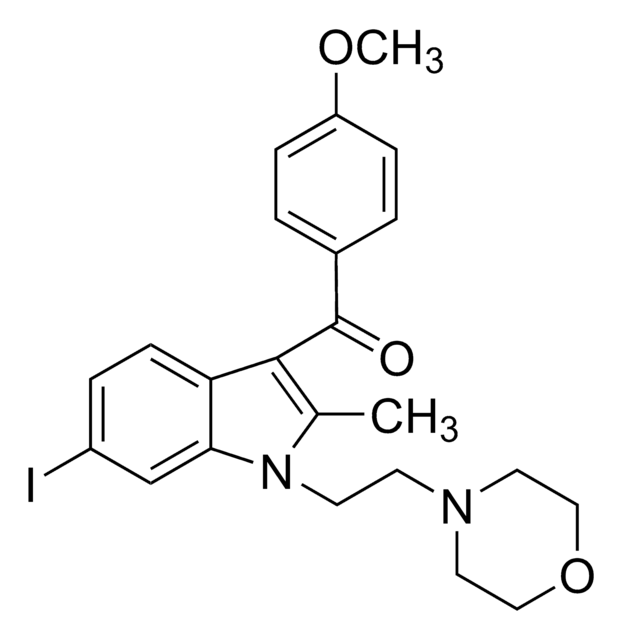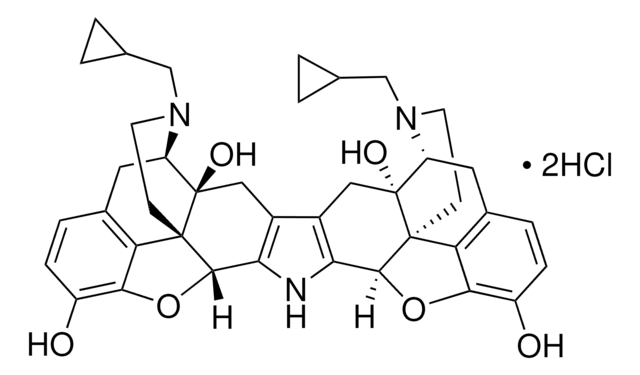S2812
SNC80
≥98% (HPLC), solid
동의어(들):
(+)-4-[(αR)-α-((2S,5R)-4-Allyl-2,5-dimethyl-1-piperazinyl)-3-methoxybenzyl]-N,N-diethylbenzamide, SNC 80, SNC-80
로그인조직 및 계약 가격 보기
모든 사진(1)
About This Item
실험식(Hill 표기법):
C28H39N3O2
CAS Number:
Molecular Weight:
449.63
MDL number:
UNSPSC 코드:
12352200
PubChem Substance ID:
NACRES:
NA.77
추천 제품
Quality Level
분석
≥98% (HPLC)
양식
solid
색상
off-white
solubility
DMSO: soluble
SMILES string
CCN(CC)C(=O)c1ccc(cc1)[C@H](N2C[C@H](C)N(CC=C)C[C@H]2C)c3cccc(OC)c3
InChI
1S/C28H39N3O2/c1-7-17-30-19-22(5)31(20-21(30)4)27(25-11-10-12-26(18-25)33-6)23-13-15-24(16-14-23)28(32)29(8-2)9-3/h7,10-16,18,21-22,27H,1,8-9,17,19-20H2,2-6H3/t21-,22+,27?/m0/s1
InChI key
KQWVAUSXZDRQPZ-QNWUEUMSSA-N
유전자 정보
human ... OPRD1(4985)
mouse ... Oprd1(18386)
rat ... Oprd1(24613) , Oprm1(25601)
애플리케이션
Rats were administered SNC80 to study the role of nitric oxide synthase in peripheral antinociception mechanism.5
생화학적/생리학적 작용
SNC80 is a highly selective agonist of δ opioid receptor but also binds to μ-δ opioid receptor heteromers to produce antinociception in mice.2 It also acts as anti-depressant3, elicits dopamine-related behaviors and enhances behavioral responses to psychostimulants.4
SNC80 is a δ opioid receptor agonist.
특징 및 장점
This compound is featured on the Opioid Receptors page of the Handbook of Receptor Classification and Signal Transduction. To browse other handbook pages, click here.
Storage Class Code
11 - Combustible Solids
WGK
WGK 3
Flash Point (°F)
Not applicable
Flash Point (°C)
Not applicable
개인 보호 장비
Eyeshields, Gloves, type N95 (US)
Paul Chu Sin Chung et al.
Behavioural brain research, 278, 429-434 (2014-12-03)
The delta opioid receptor (DOR) has raised much interest for the development of new therapeutic drugs, particularly to treat patients suffering from mood disorders and chronic pain. Unfortunately, the prototypal DOR agonist SNC80 induces mild epileptic seizures in rodents. Although
Iness Charfi et al.
Cellular and molecular life sciences : CMLS, 71(8), 1529-1546 (2013-09-12)
Signaling bias refers to G protein-coupled receptor ligand ability to preferentially activate one type of signal over another. Bias to evoke signaling as opposed to sequestration has been proposed as a predictor of opioid ligand potential for generating tolerance. Here
Chihiro Nozaki et al.
The Journal of pharmacology and experimental therapeutics, 342(3), 799-807 (2012-06-16)
N,N-diethyl-4-(5-hydroxyspiro[chromene-2,4'-piperidine]-4-yl) benzamide (ADL5859) and N,N-diethyl-3-hydroxy-4-(spiro[chromene-2,4'-piperidine]-4-yl)benzamide (ADL5747) are novel δ-opioid agonists that show good oral bioavailability and analgesic and antidepressive effects in the rat and represent potential drugs for chronic pain treatment. Here, we used genetic approaches to investigate molecular mechanisms
Josimari M DeSantana et al.
Pain, 148(1), 84-93 (2009-12-01)
Transcutaneous electrical nerve stimulation (TENS) is a treatment for pain that involves placement of electrical stimulation through the skin for pain relief. Previous work from our laboratory shows that repeated application of TENS produces analgesic tolerance by the fourth day
Laura S Moye et al.
Cephalalgia : an international journal of headache, 39(1), 77-90 (2018-05-18)
Post-traumatic headache is the most common and long-lasting impairment observed following mild traumatic brain injury, and frequently has migraine-like characteristics. The mechanisms underlying progression from mild traumatic brain injury to post-traumatic headache are not fully understood. The aim of this
자사의 과학자팀은 생명 과학, 재료 과학, 화학 합성, 크로마토그래피, 분석 및 기타 많은 영역을 포함한 모든 과학 분야에 경험이 있습니다..
고객지원팀으로 연락바랍니다.
![[D-Ala2, N-Me-Phe4, Gly5-ol]-Enkephalin acetate salt ≥97% (HPLC)](/deepweb/assets/sigmaaldrich/product/structures/227/014/768064c2-9ae6-47bd-8550-e2aa5c3b61de/640/768064c2-9ae6-47bd-8550-e2aa5c3b61de.png)
![[D-Ala2, D-Leu5]-Enkephalin acetate salt ≥95% (HPLC)](/deepweb/assets/sigmaaldrich/product/structures/934/176/d990e568-42df-43e9-a231-da7a3d9d7687/640/d990e568-42df-43e9-a231-da7a3d9d7687.png)






